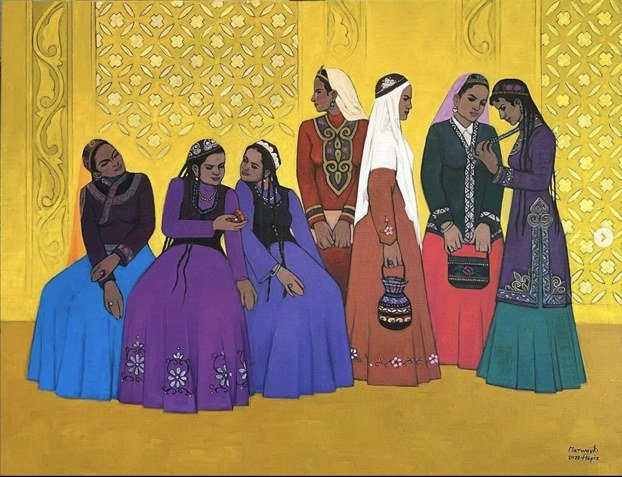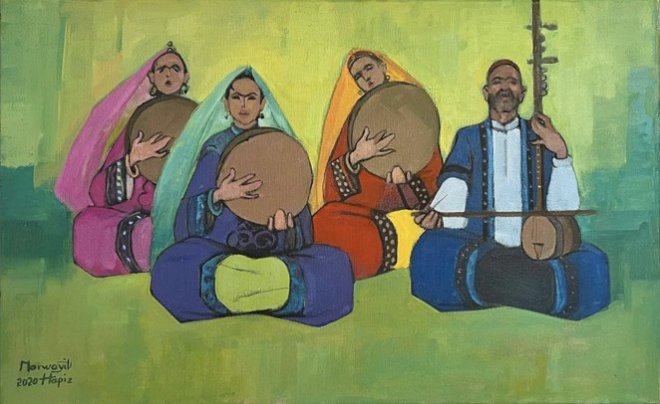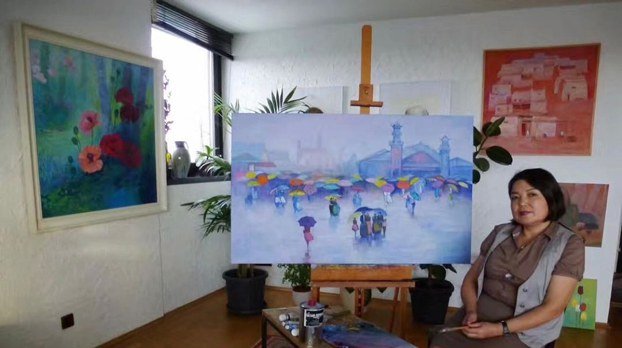INTERVIEW: ‘Our culture is disappearing now’
Marwayit Hapiz is a renowned Uyghur artist whose vivid oil paintings of everyday Uyghur life and customs are enjoyed in China’s far-western Xinjiang region, as well as in Germany, where she has lived since 1996. She was encouraged to pursue the arts at a young age by a mother who was a master embroiderer and a father who was a musician and singer, and she began painting as a teenager. During the early 1990s, Hapiz taught courses on painting at Xinjiang Normal University in Urumqi (in Chinese, Wulumuqi) until she immigrated to Germany in 1996.Hapiz"s works of art were exhibited at the Dec. 8-10 “International Conference on Preserving Uyghur Culture” in Washington, D.C., organized by the World Uyghur Academy, and at an event put on by the American Uyghur Association, alongside the work of Uyghur photographers. Hapiz recently spoke with RFA Uyghur reporter Mihray Abdilim about her artwork, the direction it has taken in recent years amid the Chinese government’s repression of the Uyghurs in Xinjiang, and her hopes for young Uyghur painters. The interview has been edited for length and clarity.
RFA: What factors laid the foundation for you to become a talented painter?
Hapiz: I started painting with passion in my early childhood. When I turned 14 years old, an art school accepted me as a student. I majored in painting and studied there for three years. When I came to understand the true meaning of painting, my studies were about to be over. At the time, the Art Institute in Lanzhou offered me admission, and I studied oil painting there for another four years. After graduation, I began working in the art department at Xinjiang Normal University.
RFA: Did your family influence your passion for art?
Hapiz: Yes, I think I inherited my parents’ art DNA, and also, because of my influence, many people have studied painting.
RFA: Just as you were becoming a famous painter in Xinjiang, you left for Germany. Why?
Hapiz: When I worked as an art teacher at Xinjiang Normal University, the university later promoted me to associate professor, but I began to feel that the advancement opportunities for my creative work were limited. After seeing world-class masterpieces in painting, I was inspired and determined to move to the societies where those master painters were born and to further develop myself. I went to Germany in early 1996 with that purpose in mind, but the life I had was different from what I expected. I was disappointed in the beginning. Life there showed me an unreachable destination. But I thought that if I didn’t give up and if I worked hard, I could have at least one painting exhibition in Europe, and that would be my blessing. I purchased painting supplies after I made some money for the first time, and I led a humble life because continuing my profession was essential to me. Because I gave up everything, which includes fame, job, position, title, love and respect to advance in my field, I could not forgive myself unless I tried very hard to realize my dream. Thus, I have sacrificed a lot.
 "Meet" by Marwayit Hapiz, oil on canvas. Credit: Marwayit Hapiz
"Meet" by Marwayit Hapiz, oil on canvas. Credit: Marwayit Hapiz
RFA: When did your paintings gain recognition in Germany?
Hapiz: I completed 40 paintings within three years after I came to Germany. I held my first exhibition in 2000, and my paintings received an unexpected warm welcome and sold out. Many Germans praised my paintings. I thought people saw my paintings positively in Germany, so I was determined to continue painting, and I am still doing it now ... Through my paintings, I make my audience feel the beauty of the world — an ancient, beautiful world they have not seen. The uniqueness of the colors and shapes in my paintings have particularly impressed them.
RFA: What is the appeal of your paintings of Uyghur life and culture for European audiences?
Hapiz: Using different colors and shapes and expressing unique content of a different world is the main factor that sparked great interest in my work. Some Germans have hung my paintings of Uyghur doppas (round skullcaps) in Keriya, bazaars, and Uyghur girls with pots in their houses. I was initially shocked when they purchased my paintings and asked myself why they like these paintings about a foreign culture which is different from their own culture. They purchased my painting titled “Narrow Street,” but they didn"t purchase my paintings of European streets. I asked them why they bought my paintings, and they said it was because the paintings gave them a wonderful poetic feeling and reminded them of an ancient, beautiful world just like the stories in “One Thousand and One Nights.” They said the color in the painting is gorgeous, and the expression was superb. That is why they bought them. Their comments showed me the importance of painting about Uyghur life.
RFA: How do Uyghurs view your paintings?
Hapiz: The Uyghurs who understand my paintings always say to me that they love my paintings, and I am their pride … For a Uyghur painter to paint Uyghur life is always good, but the environment in which every Uyghur is born and grows up is different; thus, their observation of the world, nature and life is different.
 "Musicians" by Marwayit Hapiz, oil on canvas. Credit: Marwayit Hapiz
"Musicians" by Marwayit Hapiz, oil on canvas. Credit: Marwayit Hapiz
RFA: The Chinese government in recent years arrested some of your relatives living in Xinjiang. How has this affected your work?
Hapiz: I have been marching toward my goal when it comes to my painting. The videos of the cries and sufferings of Uyghurs in the internment camps widely circulating on social media are agonizing. Many Uyghurs on social media asked me why I did not paint the internment camps. I think Uyghurs should have world-class talented people in every field. Our culture is
disappearing now. As if I am rescuing our culture through my paintings … I started to draw the disappearing culture instead of internment camps. We had such a beautiful culture. We had a magnificent palace for kings. As a descendant of a people who created this gorgeous culture to embody our pride, I am moving toward the direction that reflects this magnificent culture.
RFA: Moving towards a direction that more prominently reflects Uyghur culture?
Hapiz: Yes, to better reflect Uyghur culture. Most of the time in the past, I painted ancient streets and bazaars, and now I’m painting the magnificent palaces where our kings lived.
RFA: Is it your intention that your paintings not only convey Uyghurs’ rich culture but also give hope to Uyghurs living in Xinjiang?
Hapiz: That is what I think. However, I did not directly paint “Amannisahan” with a feeling of “a sad cry from ancient Silk Road.” I painted a Uyghur princess playing the satar. She is representative of the beauty of all Uyghur women. She is playing the satar, and in the background stands a magnificent palace. I started painting her last year and finished it last year. I tried to portray her beauty and sadness mixed with a splendid environment … I wanted to let Uyghurs everywhere know that we are a nation with a rich culture and humane soul and spirit as good as any other. And I wanted this Uyghur pride to be known among Uyghurs worldwide.
 Uyghur artist Marwayit Hapiz with some of her works. Credit: Marwayit Hapiz
Uyghur artist Marwayit Hapiz with some of her works. Credit: Marwayit Hapiz
RFA: What message would you like to give to young Uyghur painters?
Hapiz: Everything has its difficulties. One will achieve a result if one overcomes such difficulties with confidence. It has not come easy for me to speak to the audience as a painter. Everyone sees my beautiful paintings, but only I know what happened behind them. So, behind every success lies a sour life. If someone makes efforts with love, pride and confidence, he will become successful. I feel at ease now because I have never ceased the things that I wanted to do. Whatever its result, I have never stopped it. I think I have finished my difficult days now. We must have a group of educated people in the field of art. However difficult it is, one must not lose the confidence that he will succeed one day.
Translated by RFA Uyghur. Written in English by Roseanne Gerin. Edited by Joshua Lipes.
[圖擷取自網路,如有疑問請私訊]
|
本篇 |
不想錯過? 請追蹤FB專頁! |
| 喜歡這篇嗎?快分享吧! |
相關文章
AsianNewsCast






















